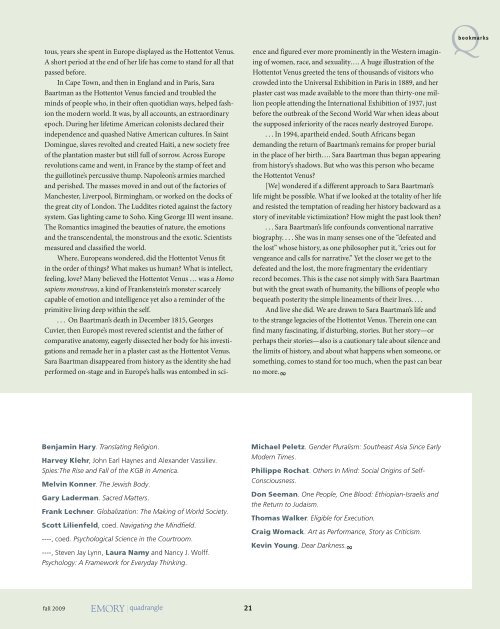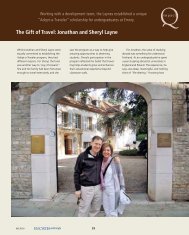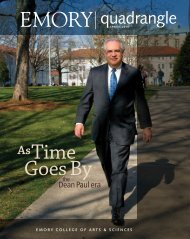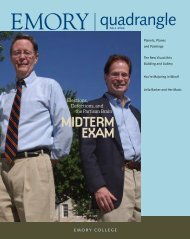quadrangle - Emory College - Emory University
quadrangle - Emory College - Emory University
quadrangle - Emory College - Emory University
- No tags were found...
Create successful ePaper yourself
Turn your PDF publications into a flip-book with our unique Google optimized e-Paper software.
tous, years she spent in Europe displayed as the Hottentot Venus.A short period at the end of her life has come to stand for all thatpassed before.In Cape Town, and then in England and in Paris, SaraBaartman as the Hottentot Venus fancied and troubled theminds of people who, in their often quotidian ways, helped fashionthe modern world. It was, by all accounts, an extraordinaryepoch. During her lifetime American colonists declared theirindependence and quashed Native American cultures. In SaintDomingue, slaves revolted and created Haiti, a new society freeof the plantation master but still full of sorrow. Across Europerevolutions came and went, in France by the stamp of feet andthe guillotine’s percussive thump. Napoleon’s armies marchedand perished. The masses moved in and out of the factories ofManchester, Liverpool, Birmingham, or worked on the docks ofthe great city of London. The Luddites rioted against the factorysystem. Gas lighting came to Soho. King George III went insane.The Romantics imagined the beauties of nature, the emotionsand the transcendental, the monstrous and the exotic. Scientistsmeasured and classified the world.Where, Europeans wondered, did the Hottentot Venus fitin the order of things? What makes us human? What is intellect,feeling, love? Many believed the Hottentot Venus … was a Homosapiens monstrous, a kind of Frankenstein’s monster scarcelycapable of emotion and intelligence yet also a reminder of theprimitive living deep within the self.. . . On Baartman’s death in December 1815, GeorgesCuvier, then Europe’s most revered scientist and the father ofcomparative anatomy, eagerly dissected her body for his investigationsand remade her in a plaster cast as the Hottentot Venus.Sara Baartman disappeared from history as the identity she hadperformed on-stage and in Europe’s halls was entombed in scienceand figured ever more prominently in the Western imaginingof women, race, and sexuality…. A huge illustration of theHottentot Venus greeted the tens of thousands of visitors whocrowded into the Universal Exhibition in Paris in 1889, and herplaster cast was made available to the more than thirty-one millionpeople attending the International Exhibition of 1937, justbefore the outbreak of the Second World War when ideas aboutthe supposed inferiority of the races nearly destroyed Europe.. . . In 1994, apartheid ended. South Africans begandemanding the return of Baartman’s remains for proper burialin the place of her birth…. Sara Baartman thus began appearingfrom history’s shadows. But who was this person who becamethe Hottentot Venus?[We] wondered if a different approach to Sara Baartman’slife might be possible. What if we looked at the totality of her lifeand resisted the temptation of reading her history backward as astory of inevitable victimization? How might the past look then?. . . Sara Baartman’s life confounds conventional narrativebiography. . . . She was in many senses one of the “defeated andthe lost” whose history, as one philosopher put it, “cries out forvengeance and calls for narrative.” Yet the closer we get to thedefeated and the lost, the more fragmentary the evidentiaryrecord becomes. This is the case not simply with Sara Baartmanbut with the great swath of humanity, the billions of people whobequeath posterity the simple lineaments of their lives. . . .And live she did. We are drawn to Sara Baartman’s life andto the strange legacies of the Hottentot Venus. Therein one canfind many fascinating, if disturbing, stories. But her story—orperhaps their stories—also is a cautionary tale about silence andthe limits of history, and about what happens when someone, orsomething, comes to stand for too much, when the past can bearno more.Benjamin Hary. Translating Religion.Harvey Klehr, John Earl Haynes and Alexander Vassiliev.Spies:The Rise and Fall of the KGB in America.Melvin Konner. The Jewish Body.Gary Laderman. Sacred Matters.Frank Lechner. Globalization: The Making of World Society.Scott Lilienfeld, coed. Navigating the Mindfield.----, coed. Psychological Science in the Courtroom.----, Steven Jay Lynn, Laura Namy and Nancy J. Wolff.Psychology: A Framework for Everyday Thinking.Michael Peletz. Gender Pluralism: Southeast Asia Since EarlyModern Times.Philippe Rochat. Others In Mind: Social Origins of Self-Consciousness.Don Seeman. One People, One Blood: Ethiopian-Israelis andthe Return to Judaism.Thomas Walker. Eligible for Execution.Craig Womack. Art as Performance, Story as Criticism.Kevin Young. Dear Darkness.fall 2009 21
















